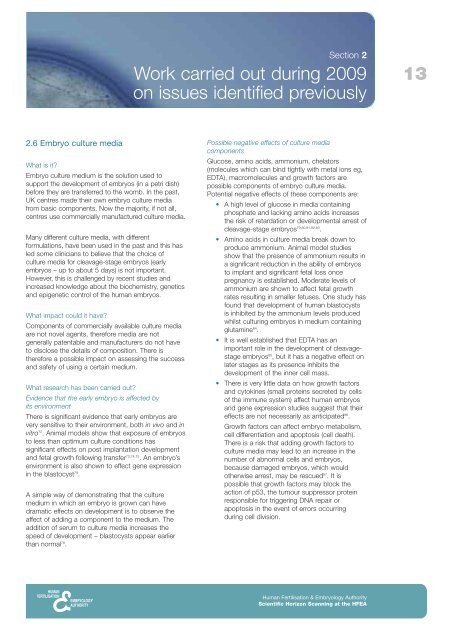Annual report 2009/10 - Human Fertilisation and Embryology Authority
Annual report 2009/10 - Human Fertilisation and Embryology Authority
Annual report 2009/10 - Human Fertilisation and Embryology Authority
Create successful ePaper yourself
Turn your PDF publications into a flip-book with our unique Google optimized e-Paper software.
Section 2<br />
Work carried out during <strong>2009</strong><br />
on issues identified previously<br />
13<br />
2.6 Embryo culture media<br />
What is it?<br />
Embryo culture medium is the solution used to<br />
support the development of embryos (in a petri dish)<br />
before they are transferred to the womb. In the past,<br />
UK centres made their own embryo culture media<br />
from basic components. Now the majority, if not all,<br />
centres use commercially manufactured culture media.<br />
Many different culture media, with different<br />
formulations, have been used in the past <strong>and</strong> this has<br />
led some clinicians to believe that the choice of<br />
culture media for cleavage-stage embryos (early<br />
embryos – up to about 5 days) is not important.<br />
However, this is challenged by recent studies <strong>and</strong><br />
increased knowledge about the biochemistry, genetics<br />
<strong>and</strong> epigenetic control of the human embryos.<br />
What impact could it have?<br />
Components of commercially available culture media<br />
are not novel agents, therefore media are not<br />
generally patentable <strong>and</strong> manufacturers do not have<br />
to disclose the details of composition. There is<br />
therefore a possible impact on assessing the success<br />
<strong>and</strong> safety of using a certain medium.<br />
What research has been carried out?<br />
Evidence that the early embryo is affected by<br />
its environment<br />
There is significant evidence that early embryos are<br />
very sensitive to their environment, both in vivo <strong>and</strong> in<br />
vitro 72 . Animal models show that exposure of embryos<br />
to less than optimum culture conditions has<br />
significant effects on post implantation development<br />
<strong>and</strong> fetal growth following transfer 73,74,75 . An embryo’s<br />
environment is also shown to effect gene expression<br />
in the blastocyst 79 .<br />
A simple way of demonstrating that the culture<br />
medium in which an embryo is grown can have<br />
dramatic effects on development is to observe the<br />
affect of adding a component to the medium. The<br />
addition of serum to culture media increases the<br />
speed of development – blastocysts appear earlier<br />
than normal 78 .<br />
Possible negative effects of culture media<br />
components<br />
Glucose, amino acids, ammonium, chelators<br />
(molecules which can bind tightly with metal ions eg,<br />
EDTA), macromolecules <strong>and</strong> growth factors are<br />
possible components of embryo culture media.<br />
Potential negative effects of these components are:<br />
• A high level of glucose in media containing<br />
phosphate <strong>and</strong> lacking amino acids increases<br />
the risk of retardation or developmental arrest of<br />
cleavage-stage embryos 79,80,81,82,83 .<br />
• Amino acids in culture media break down to<br />
produce ammonium. Animal model studies<br />
show that the presence of ammonium results in<br />
a significant reduction in the ability of embryos<br />
to implant <strong>and</strong> significant fetal loss once<br />
pregnancy is established. Moderate levels of<br />
ammonium are shown to affect fetal growth<br />
rates resulting in smaller fetuses. One study has<br />
found that development of human blastocysts<br />
is inhibited by the ammonium levels produced<br />
whilst culturing embryos in medium containing<br />
glutamine 84 .<br />
• It is well established that EDTA has an<br />
important role in the development of cleavagestage<br />
embryos 85 , but it has a negative effect on<br />
later stages as its presence inhibits the<br />
development of the inner cell mass.<br />
• There is very little data on how growth factors<br />
<strong>and</strong> cytokines (small proteins secreted by cells<br />
of the immune system) affect human embryos<br />
<strong>and</strong> gene expression studies suggest that their<br />
effects are not necessarily as anticipated 86 .<br />
Growth factors can affect embryo metabolism,<br />
cell differentiation <strong>and</strong> apoptosis (cell death).<br />
There is a risk that adding growth factors to<br />
culture media may lead to an increase in the<br />
number of abnormal cells <strong>and</strong> embryos,<br />
because damaged embryos, which would<br />
otherwise arrest, may be rescued 87 . It is<br />
possible that growth factors may block the<br />
action of p53, the tumour suppressor protein<br />
responsible for triggering DNA repair or<br />
apoptosis in the event of errors occurring<br />
during cell division.<br />
<strong>Human</strong> <strong>Fertilisation</strong> & <strong>Embryology</strong> <strong>Authority</strong><br />
Scientific Horizon Scanning at the HFEA

















